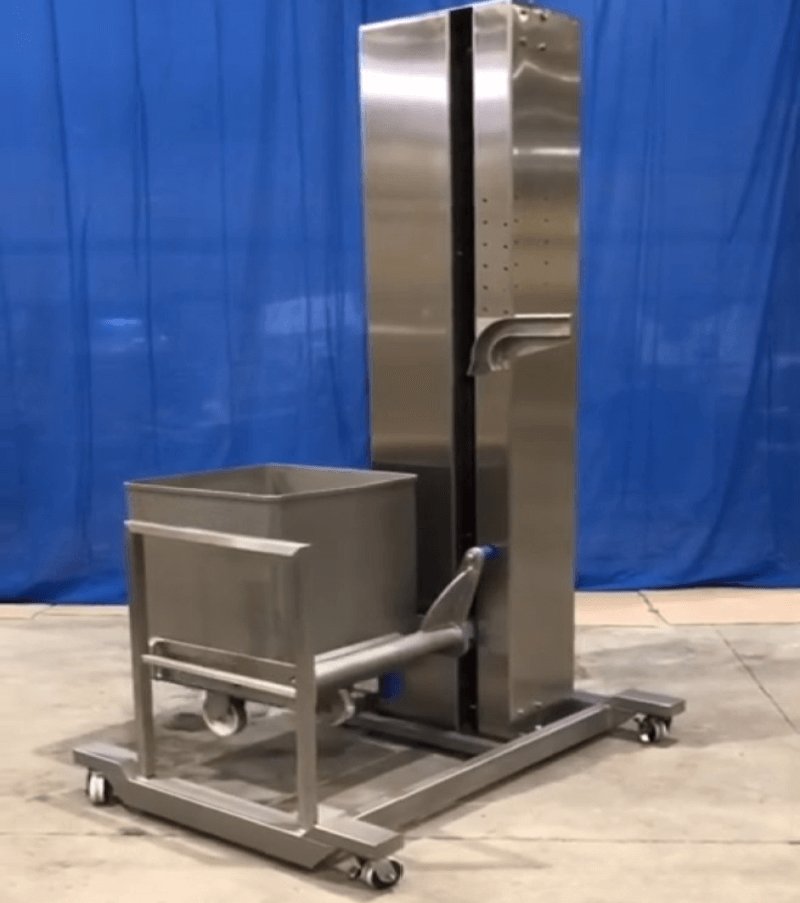Understanding Buggy Lifting Machines: A Buyer’s Guide from M&M Equipment Corp

At M&M Equipment Corp, we pride ourselves on our extensive experience in buying and selling used industrial equipment for the food industry, with a particular specialization in meat processing machinery. One of the essential pieces of equipment in this sector is the buggy lifting machine, a crucial component for efficient and safe handling of product within meat processing facilities. This blog aims to provide potential buyers with valuable insights into what to consider when purchasing a buggy lifting machine.
Background on Buggy Lifting Machines
Buggy lifting machines, also known as cart lift machines or column dumpers, play a pivotal role in the meat processing industry. They are designed to lift buggies – which are standard 400lb and 600lb stainless steel containers, also referred to as “meat trucks” or “vemag buggies” – and discharge the product into another machine for further processing. These buggies are mostly standard throughout the industry, ensuring compatibility with a range of lifting machines.
The primary function of a buggy lifting machine is to enhance the efficiency of meat processing operations by automating the transfer of product from buggies to other processing equipment. This not only speeds up production but also significantly reduces the risk of contamination and injury associated with manual handling.
Considerations for Buying a Buggy Lifting Machine
When it comes to purchasing a buggy lifting machine, there are several critical factors to consider to ensure that you select the right equipment for your needs. Here are some key aspects to keep in mind:
- Height Compatibility: The height of the machine that the buggy will be dumping into is crucial. It’s essential to ensure that the lifting machine can raise the buggy high enough to efficiently transfer the product into the next stage of processing. This requires a clear understanding of the dimensions and specifications of both the buggy lifting machine and the receiving equipment.
- Portability: Depending on the layout and operational needs of your facility, you might prefer a buggy lifter with a portable base. A portable base allows for greater flexibility in moving the equipment around the facility to meet changing production needs or to facilitate cleaning and maintenance.
- Discharge Direction: Consideration of whether you want the buggy to be lifted and discharged on the right or left side of the column is important. This decision will impact where you position the buggy lifter in your production line. Ensuring the lifter discharges in the direction that best suits your facility’s layout and workflow is essential for maintaining an efficient operation.
- Ceiling Height: The ceiling height of your factory is another critical factor. The buggy lifting machine must have enough vertical clearance to operate safely and effectively. Before making a purchase, verify the maximum height the machine will reach during operation and compare this with the available ceiling height in your facility.
Final Thoughts
Investing in the right buggy lifting machine can significantly enhance the efficiency, safety, and hygiene of your meat processing operations. By considering the factors outlined above, you can make an informed decision that meets the specific needs of your facility. At M&M Equipment Corp, we are committed to helping our clients find the best used industrial equipment for their needs. With our expertise in meat processing machinery, we can guide you through the process of selecting a buggy lifting machine that will serve your operations well into the future.
Remember, the key to making a wise investment in used industrial equipment is not just about finding the right model but also ensuring it is in good working condition and suits your operational requirements. We encourage you to reach out to us for more information and assistance in selecting the perfect buggy lifting machine for your needs.
